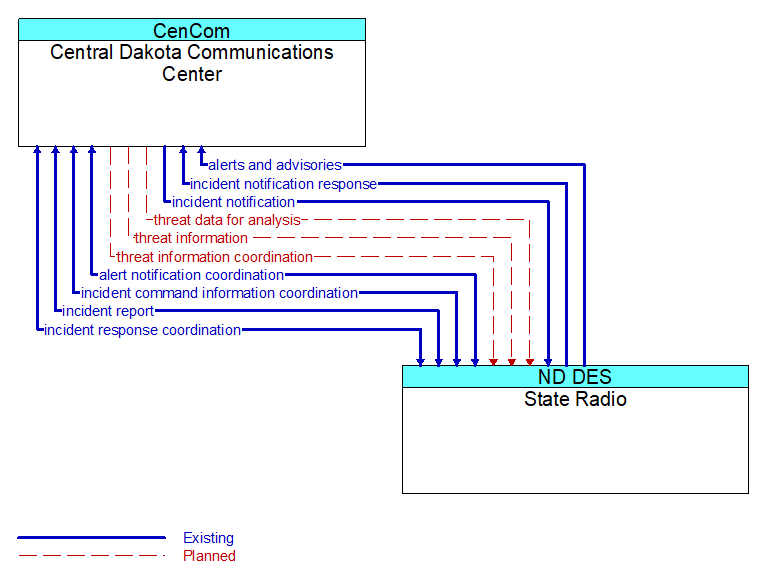Interface: Central Dakota Communications Center - State Radio

Information Flow Definitions
alert notification coordination (Existing)
Coordination of emergency alerts to be distributed to the public. This includes notification of a major emergency such as a natural or man–made disaster, civil emergency, or child abduction for distribution to the public and status of the public notification.
alerts and advisories (Existing) Selected Comm Solution
Assessments (general incident and vulnerability awareness information), advisories (identification of threats or recommendations to increase preparedness levels), and alerts (information on imminent or in–progress emergencies). This flow also provides supporting descriptive detail on incidents, threats, and vulnerabilities to increase preparedness and support effective response to threats against the surface transportation system.
incident command information coordination (Existing)
Information that supports local management of an incident. It includes resource deployment status, hazardous material information, traffic, road, and weather conditions, evacuation advice, and other information that enables emergency or maintenance personnel in the field to implement an effective, safe incident response.
incident notification (Existing)
The notification of an incident including its nature, severity, and location.
incident notification response (Existing)
Interactive acknowledgement and verification of the incident information received, requests for additional information, and general information on incident response status.
incident report (Existing)
Report of an identified incident including incident location, type, severity and other information necessary to initiate an appropriate incident response.
incident response coordination (Existing)
Incident response procedures and current incident response status that are shared between allied response agencies to support a coordinated response to incidents. This flow provides current situation information, including a summary of incident status and its impact on the transportation system and other infrastructure, and current and planned response activities. This flow also coordinates a positive hand off of responsibility for all or part of an incident response between agencies.
threat data for analysis (Planned)
Data from surveillance or sensor equipment in secure areas provided for further analysis.
threat information (Planned)
Threats regarding transportation infrastructure, facilities, or systems detected by a variety of methods (sensors, surveillance, threat analysis of advisories from outside agencies, etc.
threat information coordination (Planned)
Sensor, surveillance, and threat data including raw and processed data that is collected by sensor and surveillance equipment located in secure areas.